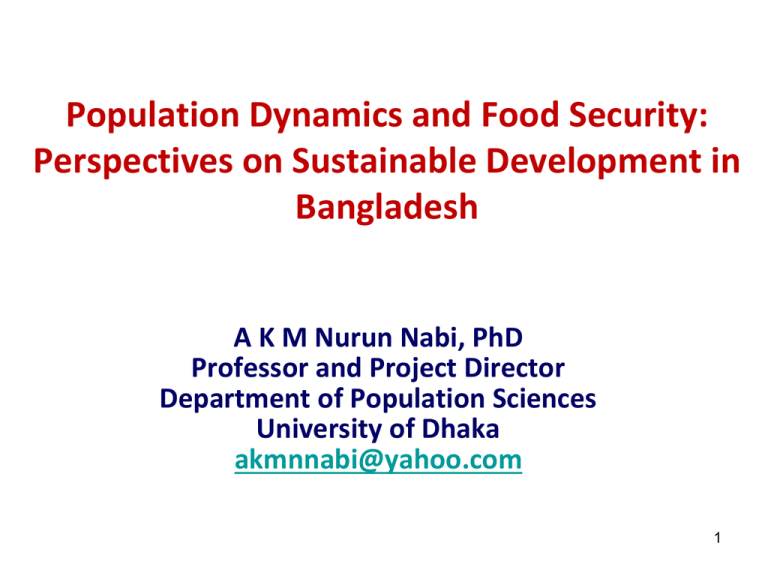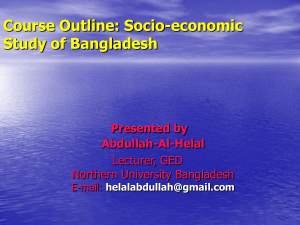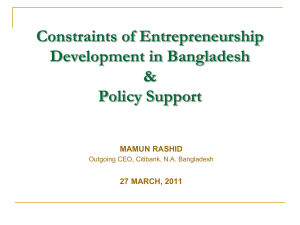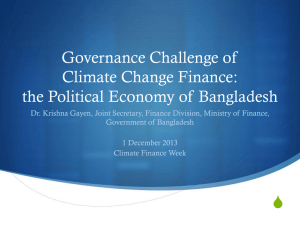Population Dynamics and Food Security: Perspectives on
advertisement

Population Dynamics and Food Security: Perspectives on Sustainable Development in Bangladesh A K M Nurun Nabi, PhD Professor and Project Director Department of Population Sciences University of Dhaka akmnnabi@yahoo.com 1 Most Populous Countries with Density, 2010 & 2050 2010 Country 2050 Population (millions) Population Density/Sq. Km. Country Population (millions) China 1,338 140 India 1,748 India 1,189 362 China 1,437 USA 310 32 Indonesia 235 Brazil USA 423 124 Pakistan 335 193 23 Nigeria 326 Pakistan 185 232 Indonesia 309 Nigeria 158 171 Bangladesh 226 Bangladesh 150 964 Brazil 215 Russia 142 8 Ethiopia 174 Japan 127 337 Congo. Demo. Rep. 166 Source: PRB, 2010 World Population Data Sheet, BBS 2011, and Mabud 2009 Bangladesh Population Outlook Bangladesh, one of the largest delta in the world, has a population size of about 150 million in an area of 147,570 sq. km. Close to 1000 people live in one square kilometer area. Each year, the population increases by 1.8 to 2.0 million. The population is likely to grow up to 226 million around 2050. The population will stabilize at 250 million by 2081, even if replacement level fertility is achieved by the year 2015. It will happen due to the population momentum inherent 3 in the young age structure. Maternal and Child Health Under 5 mortality : 65/1000 live Birth Infant Mortality : 52/1000 live Birth Neonatal mortality : 37/1000 live Birth Deaths per 1,000 live-births 160 140 120 100 80 12-59 months 1-11 months 60 40 -2.6% per year 0-28 days 20 39% 42% 45% 47% 0 1989-93 1992-6 1995-9 1999-2003 57% 2002-6 Source: Bangladesh Demographic and Health Surveys, 1993-4, 1996-7, 1999-2000, 2004, 2007 Urbanization National & urban population growth in Bangladesh 1901-2008 Census Year 1901 1911 1921 1931 1941 1951 1961 1971 1981 1991 2001 2008 National Population (million) Growth Rates 28.93 31.56 33.25 53.60 42.00 44.17 55.22 76.40 89.91 111.46 130.03 144.66 0.87 0.52 0.68 1.65 0.50 2.23 2.50 2.33 2.15 1.54 1.32 Number Percent Annual Growth Rate 0.70 0.81 0.88 1.07 1.54 1.82 2.64 6.27 13.23 20.87 28.61 36.31 2.43 2.55 2.64 3.02 3.66 4.33 5.19 8.78 15.18 19.63 23.10 25.10 1.39 0.85 2.00 3.59 1.69 3.72 6.66 10.66 4.56 3.15 6 3.37 Urban Population Dhaka Compared to Other Urban Agglomerations in 2010 & 2025 Rank Agglomeration 2010 Population Rank Agglomeration 2025 Population 1. Tokyo 36.7 1. Tokyo 37.1 2. Delhi 22.2 2. Delhi 28.6 3. 4. 5. 6. 7. 8. 9. 10. Sao Paulo Mumbai Mexico City New York Shanghai Kolkata Dhaka Karachi 20.3 20.0 19.5 19.4 16.6 15.6 14.6 13.1 3. 4. 5. 6. 7. 8. 9. 10. Mumbai Sao Paulo Dhaka Mexico City New York Kolkata Shanghai Karachi 25.8 21.7 20.9 20.7 20.6 20.1 20.0 18.7 7 Non-Slum and Slum Population by Major City Corporations City corporation Total 2001 Estimated Area in Population 2005 sq. km (in millions) Population (millions) Metropolitan 306.00 Area (DMA) Chittagong 177.39 Estimated Estimated Slum 2005 Slum 2005 non- population as Population slum percentages (millions) population of total (millions) population 6.55 9.14 3.14 6.00 37.44 3.02 4.13 1.47 2.67 35.45 Khulna 47.52 0.73 0 .97 0.19 0.78 19.49 Rajshahi 51.29 0.37 0.49 0.17 0.32 33.87 Sylhet 27.50 0.27 0.37 0.10 0.27 26.73 Barisal 51.04 0.27 0.37 0.11 0.26 30.05 Total 660.74 11.21 15.46 5.16 10.29 35.24 8 Trends in total fertility rate 6.3 5.1 4.3 3.4 1975 BFS 1989 BFS 1991 CPS 3.3 1993-94 1996-97 BDHS BDHS 3.3 19992000 BDHS 3.0 2004 BDHS 2.7 2007 BDHS Estimated Number of Women of Reproductive Age (million) 60 50 44.8 47.7 49.4 2020 2025 40.8 40 35.8 31.8 30 20 10 0 2001 2005 2010 2015 Contribution of Adolescent Fertility Year Age specific fertility rate TFR Contribution to TFR (%) 1991 179 4.3 20.8 1994 140 3.4 20.6 1997 147 3.3 22.3 2000 144 3.3 21.8 2004 135 3.0 22.5 2007 126 2.7 23.3 Female Median Age at Marriage 18 16 14 14.2 15 14.8 15.3 2000 2004 2007 12 10 8 6 4 2 0 1997 Source: BDHS 1997, 2000, 2004, 2007 The demographic structure of Bangladesh population suggests that its population will continue to grow for decades to come due to the population momentum inherent in the young age structure, even if replacement level fertility is achieved by the year 2015. However, this young population is a blessing in the sense that it implies strength, energy, vigor, pool of work force and a full potential for future leadership. For Bangladesh, this is a demographic bonus. This demographic bonus could bring a huge dividend, if this raw capital is converted into circulatory capital. This window of opportunity opens for a population only once. If we fail to grab this opportunity immediately, this young population could create a disastrous hazard for the nation. Age Structure: Young and Old Broad Age Groups Year 0-14 Yrs. (%) 15-59 Yrs. (%) 60+ Yrs. (%) 1911 42.3 53.3 4.4 1921 42.3 53.6 4.1 1931 41.9 54.9 3.2 1941 41.4 55.1 3.5 1951 42.2 53.5 4.4 1961 46.0 48.8 5.2 1974 48.0 46.3 5.7 1981 46.7 47.8 5.5 1991 45.1 49.5 5.4 2001 39.4 54.9 5.7 2005 37.9 55.9 6.2 Sources: Bangladesh Bureau of Statistics, 1994 and 1999 and 2006 14 Ageing Situation in Bangladesh Year Total Population (in million) Population (60+) % of the total 2001 130.02 7.97 6.0 2006 141.80 8.49 6.1 2011 151.41 9.77 6.5 2016 160.99 11.32 7.0 2021 171.71 14.10 8.2 2026 182.24 18.07 9.9 2031 191.61 22.15 11.6 2036 199.52 27.34 13.7 2041 206.46 31.89 15.4 2046 212.85 36.93 17.4 2051 218.64 44.10 20.2 60+ age group will exceed 0-14 age group in 2046 Distribution of Population by Age and Demographic Window of Opportunity in Bangladesh, 2005-2050 17 Projected Supply of Labour Force in Bangladesh, 2001-2051 Source: Data analysis 18 Projected Growth of GDP per Capita in Bangladesh, 2001-2051 19 Food Consumption and Nutrition Malnutrition – a serious public health & socio-economic development problem. About 35% and 21% women suffer from CED (BMI <18.5) in rural and urban areas respectively. 36 % of children are underweight (low weight-for-age). 12 % are severely underweight. Percentage of underweight children increases sharply with age and peaks at 47% among children aged 36-47. Birth weight is very low (30%). Among U-5 children 36% are stunted. 20 21 Food Security Food Security refers to accessibility and availability of foods by all groups of people all over the year in a country. Food and agriculture in Bangladesh: A success story Bangladesh has increased its food grain production substantially since its independence. From 11.8 million metric tons in 1974 to 34.5 million metric tons in 2011. 22 Total foodgrain production in the FY2010-11 34.5 million metric tons (mmt) in which the contributions of aus, aman, boro and wheat were 2.13 mmt, 12.79 mmt, 18.6 and 0.97 mmt respectively. Foodgrain production target for FY2011-12 35.73 mmt which is 3.56% higher than last year's actual production. Total foodgrain import in the FY2010-11 5.31 mmt of which 1.56 mmt was rice and 3.75mmt wheat. 23 Even though Bangladesh is now a self-sufficient in rice production, food security remains an illusive goal. Agriculture provides jobs for 80% of the total population but contributes to only 22% of the gross domestic product. Only 37% of Bangladesh’s total area is arable land but natural disasters can affect 30% of this land. 30% of the population consumes fewer than 1800 kcal per day. Women eat last and eat less. They are the most malnourished group in Bangladesh. The average Bangladeshi diet lacks diversification with 75 percent of calories consumed coming from rice. 24 A key uncertainty for the hunger situation in Bangladesh is the impact of the latest round of food price increases By early 2011 the cost of a standard bucket of food had risen by 36 percent in 12 months, with the price of rice edging ahead of its 2008 peaks. Although importing only about 5 percent of its total need, the exposure to world markets forces up local prices, disproportionately affecting poor household which spend the majority of their incomes on food. Only one percent of the country’s farms comprise more than 3 hectares. Most of the poverty and hunger in Bangladesh is found on the 86 percent of farms which are less than one hectare. 25 Agriculture engages 65% of the workforce, many of whom own no land. Furthermore, 1 percent of cultivable land is lost each year to encroachment of urban settlements, industry and infrastructure - pressures which are unlikely to diminish. Food grain production in Bangladesh has more than trebled over the last 30-40 years but soil quality has been degraded and groundwater resources depleted. 26 Despite significant achievements in poverty reduction, Bangladesh faces considerable challenges: • pockets of extreme poverty; • incidence of malnutrition is the highest in the world; • the country is most at risk from natural shocks and highly vulnerable to forecast climate change patterns; and • large areas with unfavorable agricultural environments (tidal surge prone [2 million ha], floodprone [0.75 million ha] and drought prone [1.3 million ha]). • Moreover, there exists a strong and durable interface between chronic poverty/food insecurity and unfavourable agricultural environments. 27 Women and Decision Making Women still lag a lot behind men in educational attainment, literacy, employment, earnings and control over cash, freedom of movement, autonomy and status. They lack full participation and partnership in productive and reproductive lives. Women in Bangladesh have little say over household decision-making. When it comes to making independent decisions on matters other than daily household purchases, things are even worse. While only one-third currently women decide independently on daily household purchases, only 9 to 19% make independent decisions on other matters. Climate Change The growing evidence on climate change suggests that Green House Gas (GHG) emissions, resulting from the cumulative action of developed and emerging economies, would have serious deleterious effects in near future, unless effectively contained. It is predicted that Bangladesh will be adversely affected by climate change in the form of melting of Himalayan glaciers, global warmings and rising sea level, intensified natural calamities, and greater water scarcity leading to loss of livelihood, rising unemployment and poverty. Furthermore, a rise in the sea level, leading to coastal, submergence (i.e. 17 % of Bangladesh) would cause largescale displacement of people. What Next? A few of the challenges are presented above as food for thought for all of us. To face the population challenges, we need to take the population issue as a central point for national development. On the backdrop of the global canvas of 7 billion people, what prognosis could be suggested for Bangladesh to meet the need for people’s welfare? For now, the transition from basic traditional subsistence food consumption to modern non-food consumption through rapid reduction of poverty is one precondition for appropriate national development strategy for population management and planning. Bangladesh has made significant progress in increasing agricultural productivity and output. To translate these achievements into higher food security, a more strategic multi-sectoral approach is needed. To improve the availability of food, investments are needed to: intensify and diversify food production and increase its sustainability; support adaptation to climate change; and develop agricultural marketing and infrastructure. 31 Specific entry points for action include: • increasing research and extension capacities, with special attention to the development of new rice and non-rice varieties; • developing programmes on crop diversification and increasing funding to livestock and fisheries sectors; • facilitating access to agricultural inputs and credit and ensuring that fertilisers and pesticides are used sustainably; and • protecting producers’ incentives by strengthening procurement programmes. • Increasing the number of people who can access sufficient and nutritious food. 32 • Investments to eradicate income poverty, with a particular emphasis on the most vulnerable groups, and improved risk management, will help increase and stabilize access to food. • Promoting income generation in rural areas by increasing access to markets, strengthening women’s access to productive assets, increasing valueaddition, paying special attention to the development of micro-enterprises and reforming technical and vocational training to be more gender sensitive. • In addition, safety net programs need to be expanded to the landless, marginal farmers and food insecure people in urban and disaster-prone areas. 33 Thank You 34






